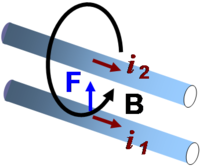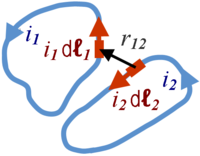Ampere's equation
In physics, more particularly in electrodynamics, Ampère's equation describes the force between two infinitesimal elements of electric-current-carrying wires. The equation is named for the early nineteenth century French physicist and mathematician André-Marie Ampère.
Rather than giving Ampère's original infinitesimal equation, which is not without problems,[1][2] we will describe two common cases obtained by integration: a system consisting of two straight wires and a system of two closed loops. Since the integrals over disputed terms in Ampère's infinitesimal equation vanish, the equations for these integrated systems are generally accepted and, moreover, are in full agreement with experiment.
Electromagnetic units
Equations will be given in two common systems of electromagnetic units (SI and Gaussian units) and to that end we define the constant k as follows,[3]
Here μ0 is the magnetic constant (also known as vacuum permeability). The quantity c is the speed of light in vacuum, in SI units a defined value denoted by c0 = 299 792 458 m s−1 (exactly).
Two straight, infinite, and parallel wires
Consider two wires, one carrying an electric current i1, the other i2. Both currents are constant in time; the wires are infinite, straight, and parallel, and a distance r apart.
The magnetic flux density B2 due to the wire with current i2 is directed in circles about wire 2, and at the distance r has magnitude (in SI units):[4]
The force F1 on wire 1 due to this magnetic flux density is found regarding the current as a movement of charge. A wire carrying a current i2 in time dt moves a charge q = i2 dt. In this time the charge moves a distance dℓ = v dt (with v the speed of the electrons traveling down the wire), suggesting i2 dℓ = q v. The Lorentz force upon the charge subject to magnetic flux density B perpendicular to the flow of charge is then radially directed with magnitude F = qvB = i2B dℓ, which is the force on each element of length dℓ of the wire. Thus, the force per unit length upon wire 1 is:
which is Ampère's law for the force per unit length l of wire. The force exerted by wire 1 on wire 2 has the same magnitude, so the subscript on the force is unnecessary. In general units, the force per unit length is:
The force F is attractive if the currents run in the same direction and repulsive if they flow in opposite direction.
Definition of the ampere
This force between straight, parallel wires is used to define the SI unit of current, the ampere, symbol A.[5] Take two infinitely long wires in vacuum at a distance r = 1 m, consider the force that one meter of these wires exert on one another (l = 1 m) and let this force be F = 2⋅10−7 N (newton). Then for i1 = i2 the current strengths are by definition both equal to one ampere (1 A). In SI units this implies that k = 10−7 N/A2 and hence that the magnetic constant is:
- μ0 = 4π k = 4π⋅10−7 N/A2.
Two loops
Let and be electric currents constant in time. They run in separate loops (closed curves) C1 and C2, see figure on the right, where all quantities are defined. The total force between two loops is given by the double path integral over the loops
Here r12 = r1−r2 is the vector locating element 1 from the location of element 2, pointing from 2 to 1.
Alternative expression
One often finds the following expression for the force between two electric-current-carrying loops:[6]
instead of the simpler expression in Eq. (1). Here the multiplication signs (×) indicate vector products. The integrand [expression under the integral of Eq. (2)] follows from the Biot-Savart-Laplace expression for the magnetic induction B(r1) due to a segment of the second loop. Insertion of B(r1) into the Lorentz force that acts on the current in segment dl1 gives the integrand of Eq. (2).
The labeling of the segments being arbitrary, one would expect the same force (in absolute value) when the labels 1 and 2 are interchanged, or in other words, one would expect Newton's third law (action is minus reaction) to hold. This is not the case, the integrand in equation (2) is non-symmetric under interchange of labels 1 and 2 and hence the integral also appears to be non-symmetric. However, after integration the expression becomes antisymmetric (changes sign under interchange of 1 and 2) and hence satisfies Newton's third law.
To see this we note that the force in Eq. (2) has in fact two contributions, as follows from a result well-known in vector analysis,
The second contribution gives an integral that is obviously equal to Eq. (1), which is manifestly antisymmetric under interchange of labels (the dot product does not change, the vector r12 changes sign). We will show that the first contribution vanishes after integration over a closed curve.
Write
where A is a short hand notation. Applying Stokes' theorem, we find that the first contribution becomes
It is well-known in vector analysis that
for any scalar function Φ and in particular for Φ ≡ 1/|r12|. Hence the first contribution to the force of Eq. (2) vanishes.
History
Ampère's original law for the force exerted upon element 1 by element 2 is (û12 = −û21):[7]
with û12 a unit vector pointing along the line joining element 2 to element 1 and r12 the length of this line. The force element is second order because it is a product of two infinitesimals. This force law leads to the same force between closed current loops as the more commonly used Grassmann's law presented above:
or, interchanging 1 and 2, the force on element 2 by element 1 is:
which is not simply opposite in sign to the previous expression. Unlike Ampère's law, Grassmann's law is not antisymmetric under exchange of the indices 1 and 2, and violates Newton's law of action opposite to reaction. Grassmann's law is readily derived from the Biot-Savart law, and is consistent with space-time symmetry. Its violation of Newton's law of action and reaction stems from its basis relying not upon action-at-a-distance, but being based instead upon a force mediated by a field, which itself has physical properties to take into account.[8] There exists some debate over the ultimate form of the force law between current elements.[9]
References
- ↑ E. Whittaker (2008). A History of the Theories of Aether and Electricity, vol. I, Reprint of 1951 2nd edition. Kessinger Publishing, LLC, pp. 85-88. ISBN 9780548967201. Also available as E. Whittaker (2011). A History of the Theories of Aether and Electricity, vol. I, Reprint of 1951 2nd edition. University of California Libraries. ISBN 1125241101.
- ↑ C. Christodoulides (1988). "Comparison of the Ampère and Biot-Savart magnetostatic force laws in their line-current-element forms". American Journal of Physics vol. 56: pp. 357-362.
- ↑ A discussion of the commonly used units is provided by Kimball A. Milton, Julian Schwinger (2006). “Appendix: Electromagnetic units”, Electromagnetic radiation: variational methods, waveguides and accelerators. Springer, pp. 347 ff. ISBN 3540293043.
- ↑ Raymond A. Serway, Jerry S. Faughn, Chris Vuille (2008). “§19.8: Magnetic force between two conductors”, College Physics Volume 2: Chapters 15-30, 8th ed. Cengage Learning, p. 645. ISBN 0495554758.
- ↑ The official definition is found at the BIPM website: Unit of electric current (ampere). BIPM. Retrieved on 2011-04-20.
- ↑ For example, Perambur S. Neelakanta (1995). Handbook of electromagnetic materials. CRC Press, p. 10. ISBN 0849325005. and Bhag S. Guru, Hüseyin R. Hızıroğlu (2004). “Ampère's force law”, Electromagnetic field theory fundamentals, 2nd ed. Cambridge University Press, p. 183. ISBN 0521830168.
- ↑ See for example, André Koch Torres Assis (1994). Weber's electrodynamics. Springer, p. 86. ISBN 0792331370. , or Marcelo de Almeida Bueno, André Koch Torres Assis (2001). “§5.1: Ampère's force”, Inductance and force calculations in electrical circuits. Nova Science Publishers, pp. 51 ff. ISBN 9781560729174.
- ↑ Thomas E Phipps, Jr. (Autumn, 1990). "Weber-like laws of action-at-a-distance in modern physics". Aperion No. 8: p. 18.
- ↑ For a discussion, see P Graneau and N Graneau (2001). "Electrodynamic force law controversy". Phys Rev vol 63 (Issue 5). DOI:10.1103/PhysRevE.63.058601. Research Blogging. and a series of essays in (1999) Andrew E. Chubykalo, Viv Pope, Roman Smirnov-Rueda, eds: Instantaneous action at a distance in modern physics: "pro" and "contra". Nova Science Publishers. ISBN 1560726989.













![{\displaystyle -ki_{1}i_{2}\oint _{C_{2}}\left[\oint _{C_{1}}(d{\boldsymbol {l}}_{1}\cdot \mathbf {A} )\,\right]d{\boldsymbol {l}}_{2}=-ki_{1}i_{2}\oint _{C_{2}}\left[\iint _{S}({\boldsymbol {\nabla }}_{1}\times \mathbf {A} )\cdot d\mathbf {S} _{1}\,\right]d{\boldsymbol {l}}_{2}.}](https://wikimedia.org/api/rest_v1/media/math/render/svg/8ba745837dbe48069b9b2592e33e171d114ca160)



